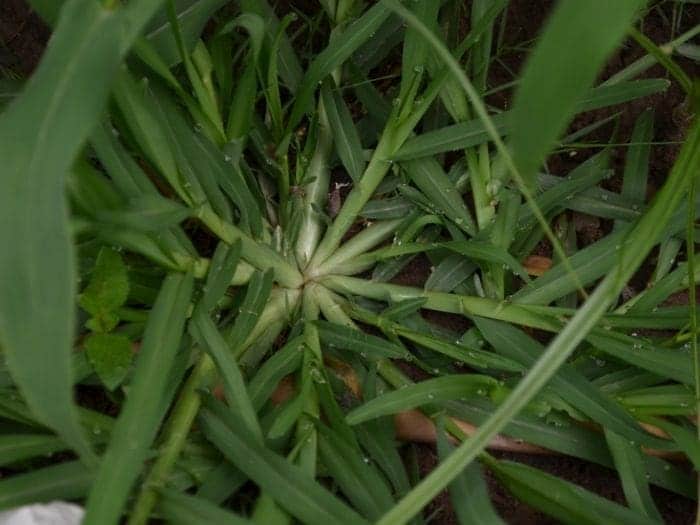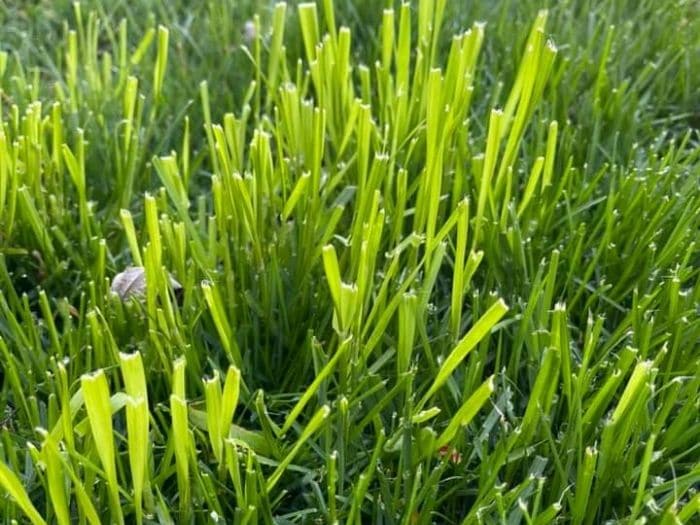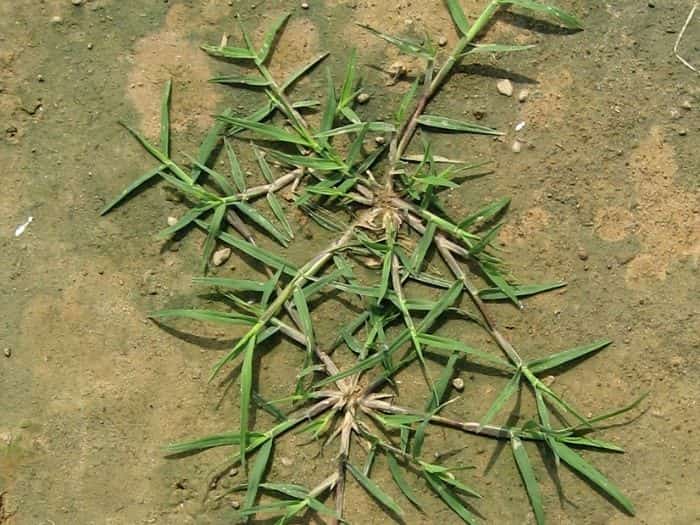How to Get Rid of Crabgrass [FOR GOOD] Spring to Summer Control
Crabgrass (Digitaria spp.) is an annual weed that thrives even in tough conditions where turfgrasses may struggle and will keep returning every year if not controlled effectively. Killing crabgrass for good depends on a holistic approach with the right herbicides and cultivation methods.
The best way to get rid of crabgrass is to apply a crabgrass preventer at the onset of spring and a post-emergent herbicide on actively growing weeds. Mow your lawn high to keep the soil shaded and prevent crabgrass from germinating. Overseed to keep a dense turf that chokes out crabgrass.
But why is crabgrass bad?
Crabgrass is bad because it flourishes in tough conditions such as drought and can grow and spread fast in thin lawns. Being a difficult weed to get rid of, crabgrass can crowd out turfgrass and take over the lawn even when there’s little water.
Can you get rid of crabgrass without killing grass?

The best way to get rid of crabgrass without killing grass is to use a selective herbicide to target the weed without harming your turfgrass. Alternatively, spot treating crabgrass with a strong lawn weed killer can get rid of isolated instances of crabgrass in your lawn successfully.
What kills crabgrass and not grass? Selective herbicides are great for controlling crabgrass without destroying turfgrass. It is still important to apply selective crabgrass killers at the recommended rate for your specific turfgrass species to prevent injury of your lawn grass.
Natural cultivation solutions can also kill crabgrass without destroying desired grass in the lawn. These include removing crabgrass with a weeder before the it goes to seed, burning, and treating the weed before it germinates.
More on these options later below.
How to Get Rid of Crabgrass
As an annual weed, crabgrass starts to germinate early in the spring, grows throughout spring and summer, and starts to die in the fall. Understanding this cycle is key for the ultimate crabgrass control plan. With this in mind…
Here’s how to get rid of crabgrass in your lawn:
1. Apply pre-emergent in spring
The first step is to apply a pre-emergent herbicide early in spring just before crabgrass seeds from the previous cycle germinate. Preemergent herbicides prevent crabgrass and other weeds from germinating in your lawn and help in controlling their population throughout your lawn care calendar for the year.
- Scotts Halts Crabgrass and Grassy Weed Preventer is one of the best pre-emergents for lawns.
- Put down a pre-emergent when soil temp reaches 55 to 70 F for at least 3 days.
- Some pre-emergents need to be watered in especially if they are granular.
Follow the instructions on the label of the product to make sure it is safe for your lawn. Some products may not be safe for newly seeded lawns, or may require that you observe a certain waiting period before seeding..
Note: Pre-emergent herbicides will not be effective in killing crabgrass once it germinates. For this, you will need to use a good crabgrass killer herbicide.
2. Apply post-emergent herbicide
If you already have crabgrass in your lawn, the best way to kill it is to apply a crabgrass post-emergent herbicide (also known as crabgrass killer) such as Tenacity Turf Herbicide.
There are two types of post-emergent weed killers: systemic and contact herbicides. Systemic herbicides are absorbed by the leaves, stems, and roots of the weed for translocation within the weed. They destroy the weed from within down to the root. Contact herbicides generally desiccate crabgrass and kill it part by part.
- It is best to apply a post-emergent herbicide before the weed goes to seed.
- Systemic crabgrass killers are more effective at controlling the weed than contact herbicides.
- Postemergent weed killers are more effective when the weeds are actively growing.
- Mature crabgrass weeds may require 2-3 applications to eliminate completely.
Pro tip: Not all crabgrass killers are safe for every turfgrass species. Weed killers that are safe for Bermuda grass may injure St. Augustine turfs. Read the product label to make sure the crabgrass control herbicide is safe for your lawn.
3. Mow your lawn high
Although crabgrass is a tough weed, it finds it hard to germinate in a healthy, thick lawn. A dense turf covers the soil, keeping the temperatures cool and unfavorable for crabgrass seeds to germinate.
One way of maintaining a thick, healthy lawn is to mow slightly higher than the recommended mowing height for your specific turfgrass. A rule of thumb is to cut not more than ⅓ of the grass blades.
Mowing high is a great way of creating a turfgrass canopy above crabgrass weeds. The shade beneath this canopy is not conducive for this weed to grow and thrive, or even compete with your turfgrass for sunlight, fertilizer, and water.
If you prefer to kill crabgrass without using chemicals, cut the grass higher as taller grass plants with higher density have a profound shading effect on the soil surface, which reduces germination of weed seeds, particularly crabgrass.
Note: Crabgrass likes to germinate when soil temperature is at least 55°F. Mature plants also struggle to grow in cold weather, that’s why the weed dies off in the fall and winter.
4. Solarize crabgrass patches in the lawn
Solarization is a natural way of killing weeds like crabgrass by covering them with clear, transparent plastic or tarp during hot weather to desiccate and destroy them with the sun’s heat. You can solarize crabgrass where there are large patches of it growing in your lawn.
Here’s how:
- Mow the lawn short in areas with crabgrass patches.
- Water the area properly at a depth of up to 2 feet.
- Cover the crabgrass patch with clear plastic.
- Secure the edges of the plastic with heavy soil to trap all the heat underneath.
- Leave it for 4 to 8 weeks for solar heat to destroy crabgrass.
- Remove the plastic cover and till the area for reseeding.
Solarization can kill crabgrass for good without the need to use chemicals because it uses natural heat from the sun. As such, it is a highly effective way of getting rid of crabgrass in the summer because it is the season when the sun is at its hottest.
The method is also very effective if you want to kill crabgrass before planting new grass seed because it can kill all the vegetation and crabgrass seed in the soil before they even germinate.
5. Pull out single crabgrass plants
Pulling out weeds from your lawn is another great way to get rid of crabgrass naturally without using chemicals. The only downside to this solution is that it’s only effective where there are just a few instances of crabgrass weeds in your lawn.
Pull out crabgrass using a weeder to make your work easier such as the Fiskars Weed Removal Tool or any other hand tool (like a trowel) that can dig up the roots of crabgrass.
It is best to uproot crabgrass before the plants go to seed if you want to prevent the weed from establishing in the lawn the following year. Mature plants may also be difficult to pull out of your lawn especially if you’re doing it by hand.
See also: Best Crabgrass Removers and How to Pull the Weed
6. Overseed in the fall
Late summer and early fall overseeding is a great way of increasing your lawn’s thickness, making it impossible for crabgrass to germinate come early spring.
When fall comes, crabgrass plants will die off on their own due to frost. As the weed bunches die, they leave behind bare spots that are typically spaces that new weeds like to grow in. Overseeding helps fill in the gaps left behind when crabgrass dies.
To get rid of crabgrass for good, overseed the lawn in the fall to repair the bare spots left behind when the weed is killed by frost. This practice is effective at controlling the population of crabgrass and other weeds because it keeps your lawn thick and full.
Here’s how to overseed and keep crabgrass out:
- Mow the grass on the lowest deck setting while bagging the clippings.
- Amend the soil with a thin layer of topsoil or organic matter.
- Rake over the area you want to overseed to loosen soil.
- Spread grass seed over the existing turf.
- Apply a good starter lawn fertilizer at the recommended rate.
- Water the overseeded area adequately.
- Pro tip: It is not a good idea to overseed a lawn with weeds. So, apply a weed killer at least 90 days prior to prevent weeds from competing with your new grass.
Overseeding not only helps control weeds such as crabgrass but also helps your turf resist disease, heavy traffic, and drought better.
Natural Ways to Get Rid of Crabgrass [Without Chemicals]
If you’re like me, organic lawn care is a great decision if you have kids and pets playing in your lawn every now and then. So, when there’s crabgrass or other types of weeds, you may want to use a natural and safe method to eliminate the weed.
There are a few options you can use to eliminate crabgrass without chemicals. Apart from using organic weed killer products, mulching, burning, and using baking soda or vinegar can help kill crabgrass.
Here are the best ways to get rid of crabgrass naturally:
Use organic vinegar
Vinegar is an organic product that’s easily found in just about every home. Out of its many uses, you can apply it as an all-natural weed killer for crabgrass so that you won’t have to use harsh chemicals that may remain in the soil for long.
To kill crabgrass, spray 5% vinegar solution on the weed, making sure to cover it completely. Repeat the applications daily over the next 3-14 days until the crabgrass dies off. Uproot the dead weed and fill in the bare spots with new grass.
Vinegar is more effective as a natural crabgrass killer at 5% or more concentration. The higher the acidity, the faster will it kill the weeds.
Caution: Vinegar is an nonselective natural weed killer. It will kill or injure any plant it comes into contact with. Spot spray crabgrass with vinegar to prevent damage to neighboring plants and turfgrass.
Apply baking soda
Baking soda is also a natural weed killer that works by desiccating plants that it comes into contact with. You can use it to get rid of crabgrass in your lawn without using chemical herbicides.
Here’s how:
Sprinkle the area with crabgrass weeds to make sure the leaves are wet enough for the baking soda to stick to them. Dust the crabgrass with a fair amount of baking soda, making sure it sticks on the wet leaves. Leave it to dry and kill the weeds in your lawn.
Once the weed is dead, pull it with a hand trowel and fill the bare spots to prevent crabgrass seeds from germinating at the onset of spring.
Burn the crabgrass
Burning subjects crabrgass to extreme heat that damages cells and tissues to a point of complete destruction. The method is great for controlling single instances of the weed in your lawn.
Use a propane torch to burn the weed to the ground. Linger the flame at the base of the weed to make sure even the roots are destroyed.
Since crabgrass has bunchy roots as opposed to some weeds that have rhizomes, you can kill it easily with a weed burner.
Pour boiling water on the weed
The advantage of using boiling water as an alternative to chemical crabgrass killers is that it can also kill dormant seeds in the soil that are waiting to germinate. The results are instant, since the extreme heat destroys plant tissue including the roots.
Here’s how to kill crabgrass with boiling water:
Pour hot, boiling water on crabgrass and a 2-foot radius at the base of the weed to kill the foliage and roots. The heat will shock and damage the roots, forcing the plant to die. You’ll see crabgrass wilting and dying off within 2 days.
Caution: Do not pour boiling water on your desired turfgrass, otherwise you’ll kill the good grass too. This method is great if you’re getting rid of crabgrass in driveways or between rocks.
Apply corn gluten
Corn gluten is useful as a natural crabgrass pre-emergent because it inhibits seed germination for many weeds.
Apply corn gluten early in April and late in July to prevent crabgrass from germinating in your lawn. For it to be effective, apply it every year for at least 3 consecutive years because it’s success rate is limited. There will still be some instances of crabgrass germinating in your yard even after applying corn gluten.
Do not use corn gluten if you intend to seed your lawn. This natural preventer will also stop turfgrass seeds from germinating, or cause poor germination.
Mulching
Mulching is a natural way to control crabgrass in garden and flower beds. It covers the soil and keeps it cool and moist, making it difficult for crabgrass to germinate.
Mulch blocks sunlight and deprives crabgrass of warmth. The cool conditions are not suitable for crabgrass seeds to germinate in the garden or flower beds.
For lawns, mulching can also help control crabgrass population especially during spring. However, if you have mature crabgrass with seedheads, you should not mulch while cutting the grass.
Summer Crabgrass Control Tips
During summer, crabgrass weeds are mature and some will have gone to seed already. Mature plants have purplish seeds that start to drop into the lawn waiting to go dormant and germinate come spring.
In summer, temperatures are high enough for some of the old seeds to germinate, but soon after, the weeds will die on their own leaving bare spots behind. Summer crabgrass control takes most of the post-emergent weed control measures that are effective.
Here’s how:
- Uproot the crabgrass plants if the infestation is not extensive.
- Apply a post-emergent crabgrass killer to get rid of mature plants.
- Overseed the lawn in late summer to crowd out young crabgrass plants.
- Bag grass clippings when mowing to reduce crabgrass population next season.
- Mow your lawn higher to keep soil temperatures cool and prevent crabgrass germination.
- Water your lawn deeply 1-2 times a week to maintain a healthy turf and keep out crabgrass.
If you want crabgrass not to come back again, let it die off in the fall and apply a crabgrass pre-emergent herbicide early in the spring. This will stop the weeds from germinating and provide season-long crabgrass control. Treat any single instances of crabgrass that may survive during spring and summer with a post-emergent herbicide.
Pre-emergent vs Post-emergent Crabgrass Control
To get rid of crabgrass for good, apply both pre-emergent and post-emergent control measures. The difference is that pre-emergents prevent the weed from germinating while post-emergents stunt and kill crabgrass post-germination.
For both methods, there are specific turfgrass weed killers that can be applied. Keep in mind that crabgrass preventers must be applied at a specific time, otherwise they will not be effective.
Here’s a list of pre-emergents and post-emergents that are available on the market today:
| Crabgrass Herbicide | Type |
| Syngenta Tenacity Turf Herbicide | Pre and postemergent |
| Preen Lawn Weed Control Plus Crabgrass Preventer | Pre-emergent |
| Scotts® Turf Builder® Halts Crabgrass Preventer with Lawn Food | Pre-emergent (weed and feed) |
| Spectracide Weed Stop For Lawns Plus Crabgrass Killer Concentrate | Post-emergent |
| MENARDS® PREMIUM Crabgrass Preventer Lawn Fertilizer | Pre-emergent |
| Ortho® Weed B Gon® Plus Crabgrass Control | Post-emergent |
| Dimension 2EW Pre-Emergent Herbicide | Pre and post-emergent |
| Drive Xlr8 Herbicide Crabgrass Killer | Post-emergent |
| Scotts Halts Crabgrass & Grassy Weed Preventer | Pre-emergent |
| Roundup for Lawns Crabgrass Destroyer | Post-emergent |
| Lesco Dimension Crabgrass Pre-Emergent | Preemergent |
| Pennington Ultragreen Crabgrass Preventer Plus Fertilizer | Pre-emergent |
| QuinKill Max Crabgrass and Weed Killer | Post-emergent |
| Fertilome Weed Out With Crabgrass Killer | Post-emergent |
References + Resources
- G.T. Lyman, June 8, 2015, “Mowing Lawn Turf (E0013TURF)” Michigan State University Extension
- University of Missouri, Integrated Pest Management: Proper Mowing Practices for Your Lawn
- CLYDE L. ELMORE et al, Extension Weed Scientist, Vegetable Crops Department: Soil Solarization: A Nonpesticidal Method for Controlling Diseases, Nematodes, and Weeds
- University of Maryland Extension: Corn Gluten for Crabgrass Control

![When to Apply Crabgrass Preventer [Before or After Rain?]](https://lawnmodel.com/wp-content/uploads/2021/03/When-to-apply-crabgrass-preventer-min.jpg)


